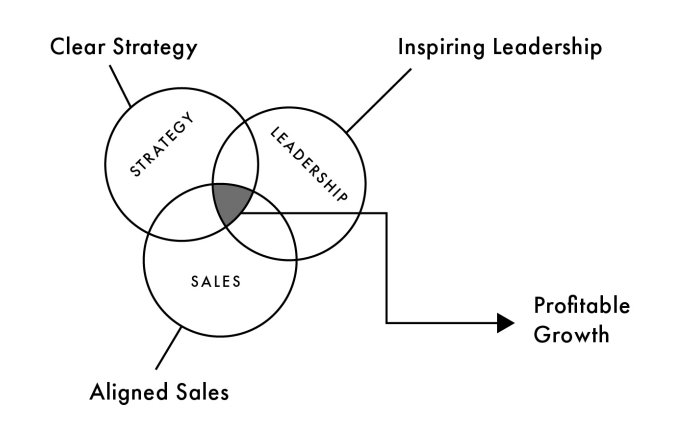By: Elowen Gray
For any business, growth isn’t optional. It is essential. But too often, companies treat the areas of leadership, strategy, and sales as wholly separate areas of focus, missing the opportunity to align them in a way that fuels sustained success. Scott K. Edinger, a leadership and strategy adviser and author of The Growth Leader: Strategies to Drive the Top and Bottom Lines, argues that the real key to growth lies in the integration of these three critical functions.
Edinger’s work suggests that many CEOs face challenges in aligning their sales teams with strategy, which can lead to gaps between a company’s vision and its execution. Companies fall into the trap of chasing short-term wins rather than building sustainable, strategic growth. Leaders must take an active role in ensuring that the sales organization is aligned with the corporate strategy. Closing that gap isn’t only a sales issue. It’s a leadership imperative.
The Interplay of Leadership, Strategy, and Sales
Leadership, strategy, and sales should function as an integrated system, like the Venn diagram below, not as separate initiatives. Leadership defines the vision. Strategy outlines the path forward. Sales executes that strategy in the market. When these elements work together, companies create alignment, build momentum, and outperform the competition. As illustrated by the following diagram from Edinger’s book:

Yet, too often, these areas of focus operate in isolation. Leadership develops a strategy that never reaches the frontlines. Sales teams focus on quotas rather than long-term customer relationships. Strategy becomes a mathematics exercise instead of a practical roadmap for execution.
This disconnect is not simply a sales issue. It’s a leadership issue. As Edinger points out, sustained growth requires leaders to take responsibility for connecting strategy to execution. When they do, they create the clarity and focus that enable sales teams to pursue the right opportunities, build stronger customer relationships, and deliver results that align with the company’s long-term goals.
Leadership’s Role in Sales Performance
Leadership isn’t about sitting in a corner office, disconnected from the realities of sales. It’s about shaping the strategy and culture to support growth. It’s about inspiring, motivating, and driving the behaviors that drive success.
Edinger’s research indicates that employees who feel genuinely inspired by their leaders may be significantly more productive than those who are simply satisfied in their roles, especially for sales teams, where resilience, motivation, and relationship-building are critical. This inspiration can be a performance multiplier.
Great leaders don’t just set revenue targets; they cultivate an environment where their teams feel a sense of purpose about creating value for customers. They help ensure that sales professionals understand not only what they’re selling but how they create value, and why it matters. They make a culture where sales is a strategic driver of growth rather than a transactional function.
Breaking the Sales Stigma
Despite its critical role in driving company growth, sales still carry a stigma in many organizations. Executives frequently see sales as crucial, but not strategic. A perspective shaped by outdated stereotypes and a limited understanding of the sophistication and skill required for success in contemporary sales. This obsolete perception stifles growth and innovation.
Edinger challenges that mindset. Modern sales professionals are not just walking, talking, presenting brochures, and pushing products. They are advisers, problem solvers, and value creators. Effective organizations recognize this and build sales teams with business acumen, strategic thinking, and deep product knowledge and technical expertise.
Reframing the role of sales within an organization starts at the top. This shift begins with leadership. When executives view sales as a strategic function, and communicate its importance accordingly, they elevate its influence across the business. This not only attracts stronger talent but helps ensure that sales is fully aligned with the company’s vision, priorities, and long-term success.
Aligning Sales with Strategic Objectives
A brilliant strategy is useless if it doesn’t reach your customers. Yet many sales teams operate with a limited understanding of the company’s direction. Research from The Growth Leader found that sales professionals, on average, rate their grasp of company strategy at just 4.2 out of 10. That is a considerable risk when leaders understand that sales drive the execution of their strategy in the market. Every sales call reflects the success or failure of your strategy.
Closing the gap requires more than training sessions or updated messaging. It calls for sustained leadership involvement.
Leaders must ensure that sales teams understand which types of business align with corporate goals and which types don’t, how to connect their offerings and solutions to the highest priority customer needs, and what kind of customer relationships will drive sustainable success.
This isn’t about micromanaging. It’s about engaging with the sales organization, reinforcing priorities, and ensuring the strategic direction is reflected in every customer interaction. That kind of consistent communication is how you build a high-performing, aligned sales organization.
When leadership, strategy, and sales are truly aligned, real growth follows. Several organizations have seen that firsthand. Companies like L3Harris, GTE Financial, a major global manufacturer, TK Elevator, and Vari have turned to Edinger to help bring clarity to their strategy, strengthen their leadership, and create cultures that perform. Whether working with Fortune 500 giants or fast-moving startups, his role has often been to help leaders connect the dots between big-picture vision and day-to-day execution.
Case Study: Strategic Transformation Through Alignment
One global manufacturing services firm facing intense competitive pressure made a significant investment in expanding its offerings to deliver more comprehensive solutions to its clients. The strategy was sound, but execution lagged.
When Edinger engaged with the company, it became clear that while leadership communicated the new direction, the organization was not equipped to execute it. The strategy called for a shift in how the company engaged customers, but that shift hadn’t taken root. Sales teams defaulted to familiar products and buyers rather than embracing the broader, more solution-oriented approach required to support the company’s evolving value proposition.
To close the gap between strategy and execution, the company worked with Edinger on a transformation that included:
Strategy Clarification and Alignment: Translating the high-level ideas in the strategy into pragmatic frameworks that guided sales action in the field. This helped teams connect their daily efforts to the broader direction of the business, ensuring cohesive execution across all levels.
Sales Development and Strategy Execution: Sales teams adopted a consultative approach focused on creating value for customers rather than simply pitching products. Emphasis was placed on engaging senior decision-makers, solving business problems, and positioning the company as a strategic partner. Leaders were equipped to act as coaches, reinforcing new behaviors and ensuring accountability.
Leadership Development and Engagement: Executives were coached to reinforce strategic direction, support new behaviors in the field, and lead in a way that modeled clarity, focus, and alignment.
The outcome was a noticeable uptick in how the organization executed its strategy. Customer relationships strengthened, sales effectiveness improved, and critical growth initiatives gained traction. Just as importantly, the company emerged better equipped to meet future challenges – with leaders actively aligning strategy and sales to drive performance.
The Path to Sustainable Growth
The integration of leadership, strategy, and sales isn’t just a nice-to-have; it’s a competitive advantage. When these elements are in sync, companies don’t just survive; they thrive.
Scott K. Edinger’s insights offer a roadmap for business leaders looking to bridge the gap between vision and execution. By actively engaging in the sales process as the driver of strategic success in the market, eliminating outdated perceptions about sales, and ensuring alignment of your strategy, organizations can create a foundation for long-term success.
Customer expectations are higher than ever today. Businesses that master this integration will be the ones that define the future of their industries. Leadership, strategy, and sales – when aligned and working in unison – form the ultimate formula for sustained growth.
Disclaimer: The information provided in this article is for general informational purposes only and is not intended as professional advice. While we strive for accuracy, we make no representations or warranties, express or implied, about the completeness, accuracy, reliability, suitability, or availability of this information. Use of this information is at your own risk.






